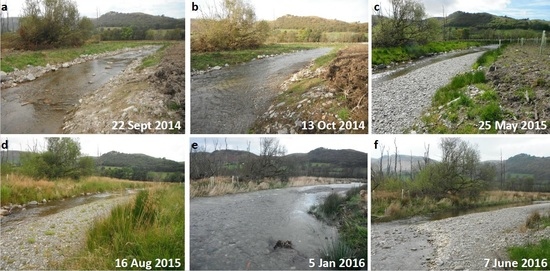Flow Hydrodynamics across Open Channel Flows with Riparian Zones: Implications for Riverbank Stability
Abstract
:1. Introduction
- Flow hydrodynamics were measured across an open channel with a riverbank, for a range of riverbank vegetation densities, representative of natural systems.
- At the main channel, bed-shear stresses increase nearly twofold with a change from no vegetation to the dense vegetation (λ = 1.9 m−1).
- Near the riverbank toe, turbulence intensity reduces up to 40% for the cases of low to high vegetation densities (λ ≈ 0 to 1.9 m−1).
- Recommendations are offered for improving the existing practices deploying riverbank revegetation as an environmentally sustainable method against riverbank destabilization.
2. Materials and Methods
3. Results
3.1. Streamwise Velocity
3.2. Bed-Shear Stresses
3.3. Turbulence Intensity
4. Discussion
4.1. Interactions between Riparian Vegetation and Hydrogeomorphology
4.2. Case Studies and Best Practices: Examples from the UK
4.3. Implications for Riverbank Stability
5. Conclusions
Acknowledgments
Author Contributions
Conflicts of Interest
References
- Gurnell, A.M. Plants as river system engineers. Earth Surf. Process. Landf. 2014, 39, 4–25. [Google Scholar] [CrossRef]
- Scottish Environment Protection Agency (SEPA). Reducing river bank erosion. In A Best Practice Guide for Farmers and Other Land Managers; Scottish Environment Protection Agency: Stirling, UK, 2016. [Google Scholar]
- Scottish Environment Protection Agency (SEPA). Engineering in the water environment good practice guide. In Bank Protection: Rivers and Lochs, 1st ed.; Scottish Environment Protection Agency: Stirling, UK, 2008. [Google Scholar]
- Iowa Department of Natural Resources. How to Control Streambank Erosion; Natural Resources Conservation Service, U.S. Department of Agriculture, Ed.; Iowa Department of Natural Resources: Des Moines, IA, USA, 2006.
- Zong, L.; Nepf, H. Flow and deposition in and around a finite patch of vegetation. Geomorphology 2010, 116, 363–372. [Google Scholar] [CrossRef]
- Valyrakis, M.; Kitsikoudis, V.; Yagci, O.; Kirca, V.S.O.; Koursari, E. Experimental investigation of the modification of the flow field, past emergent aquatic vegetation elements. In Proceedings of the 36th IAHR World Congress, The Hague, The Netherlands, 28 June–3 July 2015. [Google Scholar]
- Yagci, O.; Celik, M.F.; Kitsikoudis, V.; Ozgur Kirca, V.S.; Hodoglu, C.; Valyrakis, M.; Duran, Z.; Kaya, S. Scour patterns around isolated vegetation elements. Adv. Water Resour. 2016, 97, 251–265. [Google Scholar] [CrossRef]
- Yager, E.M.; Schmeeckle, M.W. The influence of vegetation on turbulence and bed load transport. J. Geophys. Res. Earth Surf. 2013, 118, 1585–1601. [Google Scholar] [CrossRef]
- Wilson, C.A.M.E.; Stoesser, T.; Bates, P.D.; Pinzen, A.B. Open channel flow through different forms of submerged flexible vegetation. J. Hydraul. Eng. 2003, 129, 847–853. [Google Scholar] [CrossRef]
- Rominger, J.T.; Lightbody, A.F.; Nepf, H.M. Effects of added vegetation on sand bar stability and stream hydrodynamics. J. Hydraul. Eng. 2010, 136, 994–1002. [Google Scholar] [CrossRef]
- Hopkinson, L.; Wynn, T. Vegetation impacts on near bank flow. Ecohydrology 2009, 2, 404–418. [Google Scholar] [CrossRef]
- Czarnomski, N.M.; Tullos, D.D.; Thomas, R.E.; Simon, A. Effects of vegetation canopy density and bank angle on near-bank patterns of turbulence and reynolds stresses. J. Hydraul. Eng. 2012, 138, 974–978. [Google Scholar] [CrossRef]
- Afzalimehr, H.; Najfabadi, E.F.; Singh, V.P. Effect of vegetation on banks on distributions of velocity and reynolds stress under accelerating flow. J. Hydraul. Eng. 2010, 15, 708–713. [Google Scholar] [CrossRef]
- Darby, S.E.; Thorne, C.R.; Member, A. Predicting stage-discharge curves in channels with bank vegetation. J. Hydraul. Eng. 1996, 122, 583–586. [Google Scholar] [CrossRef]
- Thorne, C.R.; Hey, R.D.; Newson, M.D. Applied Fluvial Geomorphology for River Engineering and Management; John Wiley & Sons: Chichester, UK, 1997. [Google Scholar]
- Couper, P.R.; Maddock, I.P. Subaerial river bank erosion processes and their interaction with other bank erosion mechanisms on the river arrow, Warwickshire, UK. Earth Surf. Process. Landf. 2001, 26, 631–646. [Google Scholar] [CrossRef]
- Lawler, D.M.; Grove, J.R.; Couperthwaite, J.S.; Leeks, G.J.L. Downstream change in river bank erosion rates in the swale-ouse system, northern england. Hydrol. Process. 1999, 13, 977–992. [Google Scholar] [CrossRef]
- Carson, M.A.; Kirkby, M.J. Hillslope Form and Process; Cambridge University Press: London, UK, 1972. [Google Scholar]
- Hubble, T.C.T.; Docker, B.B.; Rutherfurd, I.D. The role of riparian trees in maintaining riverbank stability: A review of australian experience and practice. Ecol. Eng. 2010, 36, 292–304. [Google Scholar] [CrossRef]
- Erskine, W.; Keene, A.; Bush, R.; Cheetham, M.; Chalmers, A. Influence of riparian vegetation on channel widening and subsequent contraction on a sand-bed stream since european settlement: Widden brook, Australia. Geomorphology 2012, 147–148, 102–114. [Google Scholar] [CrossRef]
- Chen, S.-C.; Chan, H.-C.; Li, Y.-H. Observations on flow and local scour around submerged flexible vegetation. Adv. Water Resour. 2012, 43, 28–37. [Google Scholar] [CrossRef]
- Kui, L.; Stella, J.C.; Lightbody, A.; Wilcox, A.C. Ecogeomorphic feedbacks and flood loss of riparian tree seedlings in meandering channel experiments. Water Resour. Res. 2014, 50, 9366–9384. [Google Scholar] [CrossRef]
- Schmeeckle, M.W. Numerical simulation of turbulence and sediment transport of medium sand. J. Geophys. Res. Earth Surf. 2014, 119, 1240–1262. [Google Scholar] [CrossRef]
- Valyrakis, M.; Diplas, P.; Dancey, C.L. Prediction of coarse particle movement with adaptive neuro-fuzzy inference systems. Hydrol. Process. 2011, 25, 3513–3524. [Google Scholar] [CrossRef]
- Valyrakis, M.; Diplas, P.; Dancey, C.L. Entrainment of coarse grains in turbulent flows: An extreme value theory approach. Water Resour. Res. 2011, 47, W09512. [Google Scholar] [CrossRef]
- Da Silva, Y.J.A.B.; Cantalice, J.R.B.; Singh, V.P.; Cruz, C.M.C.A.; Silva Souza, W.L.D. Sediment transport under the presence and absence of emergent vegetation in a natural alluvial channel from brazil. Int. J. Sediment Res. 2016, 31, 360–367. [Google Scholar] [CrossRef]
- Nepf, H.M. Drag, turbulence, and diffusion in flow through emergent vegetation. Water Resour. Res. 1999, 35, 479–489. [Google Scholar] [CrossRef]
- Tsujimoto, T.; Shimizu, Y.; Kitamura, T.; Okada, T. Turbulent open-channel flow over bed covered by rigid vegetation. J. Hydrosci. Hydraul. Eng. 1992, 10, 13–25. [Google Scholar]
- Vectrino Velocimeter User Guide. Available online: http://www.nortek-as.com/en/support/manuals (accessed on 19 September 2017).
- Goring, D.G.; Nikora, V.I. Despiking acoustic Doppler velocimeter data. J. Hydraul. Eng. 2002, 128, 117–126. [Google Scholar] [CrossRef]
- Lohrmann, A.; Cabrera, R.; Karus, N.C. Acoustic-Doppler velocimeter (ADV) for laboratory use. In Hydraulic Measurements and Experimentation, Proceedings Sponsored by Hydraulics Division/ASCE, Buffalo, NY, USA, 1–5 August 1994; ASCE: Reston, VA, USA, 1994; pp. 351–365. [Google Scholar]
- Khorsandi, B.; Mydlarski, L.; Gaskin, S. Noise in turbulence measurements using acoustic doppler velocimetry. J. Hydraul. Eng. 2012, 138, 829–838. [Google Scholar] [CrossRef]
- Yang, J.Q.; Chung, H.; Nepf, H.M. The onset of sediment transport in vegetated channels predicted by turbulent kinetic energy. Geophys. Res. Lett. 2016. [Google Scholar] [CrossRef]
- Guo, J.; Julien, P.Y. Shear stress in smooth rectangular open-channel flows. J. Hydraul. Eng. 2005, 131, 30–37. [Google Scholar] [CrossRef]
- Cheng, N.-S. Representative grain size and equivalent roughness height of a sediment bed. J. Hydraul. Eng. 2016, 142, 06015016. [Google Scholar] [CrossRef]
- Camenen, B.; Larson, M.; Bayram, A. Equivalent roughness height for plane bed under oscillatory flow. Estuar. Coast. Shelf Sci. 2009, 81, 409–422. [Google Scholar] [CrossRef]
- Nepf, H.M. Hydrodynamics of vegetated channels. J. Hydraul. Eng. 2012, 50, 262–279. [Google Scholar] [CrossRef]
- Edmaier, K.; Burlando, P.; Perona, P. Mechanisms of vegetation uprooting by flow in alluvial non-cohesive sediment. Hydrol. Earth Syst. Sci. 2011, 15, 1615–1627. [Google Scholar] [CrossRef] [Green Version]
- Beechie, T.J.; Sear, D.A.; Olden, J.D.; Pess, G.R.; Buffington, J.M.; Moir, H.; Roni, P.; Pollock, M.M. Process-based principles for restoring river ecosystems. BioScience 2010, 60, 209–222. [Google Scholar] [CrossRef]
- Wohl, E.; Lane, S.N.; Wilcox, A.C. The science and practice of river restoration. Water Resour. Res. 2015, 51, 5974–5997. [Google Scholar] [CrossRef]
- Curran, J.C.; Hession, W.C. Vegetative impacts on hydraulics and sediment processes across the fluvial system. J. Hydrol. 2013, 505, 364–376. [Google Scholar] [CrossRef]
- Osterkamp, W.R.; Hupp, C.R.; Stoffel, M. The interactions between vegetation and erosion: New directions for research at the interface of ecology and geomorphology. Earth Surf. Process. Landf. 2012, 37, 23–36. [Google Scholar] [CrossRef]
- Steiger, J.; Tabacchi, E.; Dufour, S.; Corenblit, D.; Peiry, J.L. Hydrogeomorphic processes affecting riparian habitat within alluvial channel–floodplain river systems: A review for the temperate zone. River Res. Appl. 2005, 21, 719–737. [Google Scholar] [CrossRef]
- McShane, R.R.; Auerbach, D.A.; Friedman, J.M.; Auble, G.T.; Shafroth, P.B.; Merigliano, M.F.; Scott, M.L.; Poff, N.L. Distribution of invasive and native riparian woody plants across the western USA in relation to climate, river flow, floodplain geometry and patterns of introduction. Ecography 2015, 38, 1254–1265. [Google Scholar] [CrossRef]
- Gurnell, A.M.; Boitsidis, A.J.; Thompson, K.; Clifford, N.J. Seed bank, seed dispersal and vegetation cover: Colonization along a newly-created river channel. J. Veg. Sci. 2006, 17, 665–674. [Google Scholar] [CrossRef]
- Burt, S.; McCarthy, M.; Kendon, M.; Hannaford, J. Cumbrian floods, 5/6 December 2015. Weather 2016, 71, 36–37. [Google Scholar] [CrossRef]
- Pasquale, N.; Perona, P.; Francis, R.; Burlando, P. Effects of streamflow variability on the vertical root density distribution of willow cutting experiments. Ecol. Eng. 2012, 40, 167–172. [Google Scholar] [CrossRef]
- Polvi, L.E.; Wohl, E.; Merritt, D.M. Modeling the functional influence of vegetation type on streambank cohesion. Earth Surf. Process. Landf. 2014, 39, 1245–1258. [Google Scholar] [CrossRef]
- Tron, S.; Perona, P.; Gorla, L.; Schwarz, M.; Laio, F.; Ridolfi, L. The signature of randomness in riparian plant root distributions. Geophys. Res. Lett. 2015, 42, 7098–7106. [Google Scholar] [CrossRef]
- Pasquale, N.; Perona, P.; Schneider, P.; Shrestha, J.; Wombacher, A.; Burlando, P. Modern comprehensive approach to monitor the morphodynamic evolution of a restored river corridor. Hydrol. Earth Syst. Sci. 2011, 15, 1197–1212. [Google Scholar] [CrossRef] [Green Version]
- Perona, P.; Camporeale, C.; Perucca, E.; Savina, M.; Molnar, P.; Burlando, P.; Ridolfi, L. Modelling river and riparian vegetation interactions and related importance for sustainable ecosystem management. Aquat. Sci. 2009, 71, 266–278. [Google Scholar] [CrossRef]
- Chen, L.; Acharya, K.; Stone, M.C. Using a mechanical approach to quantify flow resistance by submerged, flexible vegetation—A revisit of kouwen’s approach. Adv. Water Resour. 2014, 73, 198–202. [Google Scholar] [CrossRef]
- Diplas, P.; Dancey, C.L.; Celik, A.O.; Valyrakis, M.; Greer, K.; Akar, T. The role of impulse on the initiation of particle movement under turbulent flow conditions. Science 2008, 322, 717–720. [Google Scholar] [CrossRef] [PubMed]
- Valyrakis, M.; Diplas, P.; Dancey, C.L.; Greer, K.; Celik, A.O. Role of instantaneous force magnitude and duration on particle entrainment. J. Geophys. Res. Earth Surf. 2010, 115, F02006. [Google Scholar] [CrossRef]
- Perona, P.; Molnar, P.; Savina, M.; Burlando, P. An observation-based stochastic model for sediment and vegetation dynamics in the floodplain of an alpine braided river. Water Resour. Res. 2009, 45, W09418. [Google Scholar] [CrossRef]
- Poggi, D.; Porporato, A.; Ridolfi, L.; Albertson, J.D.; Katul, G.G. The effect of vegetation density on canopy sub-layer turbulence. Bound.-Layer Meteorol. 2004, 111, 565–587. [Google Scholar] [CrossRef]
- Rominger, J.T.; Nepf, H.M. Flow adjustment and interior flow associated with a rectangular porous obstruction. J. Fluid Mech. 2011, 680, 636–659. [Google Scholar] [CrossRef]
- Belcher, S.E.; Jerram, N.; Hunt, J.C.R. Adjustment of a turbulent boundary layer to a canopy of roughness elements. J. Fluid Mech. 2003, 488, 369–398. [Google Scholar] [CrossRef]


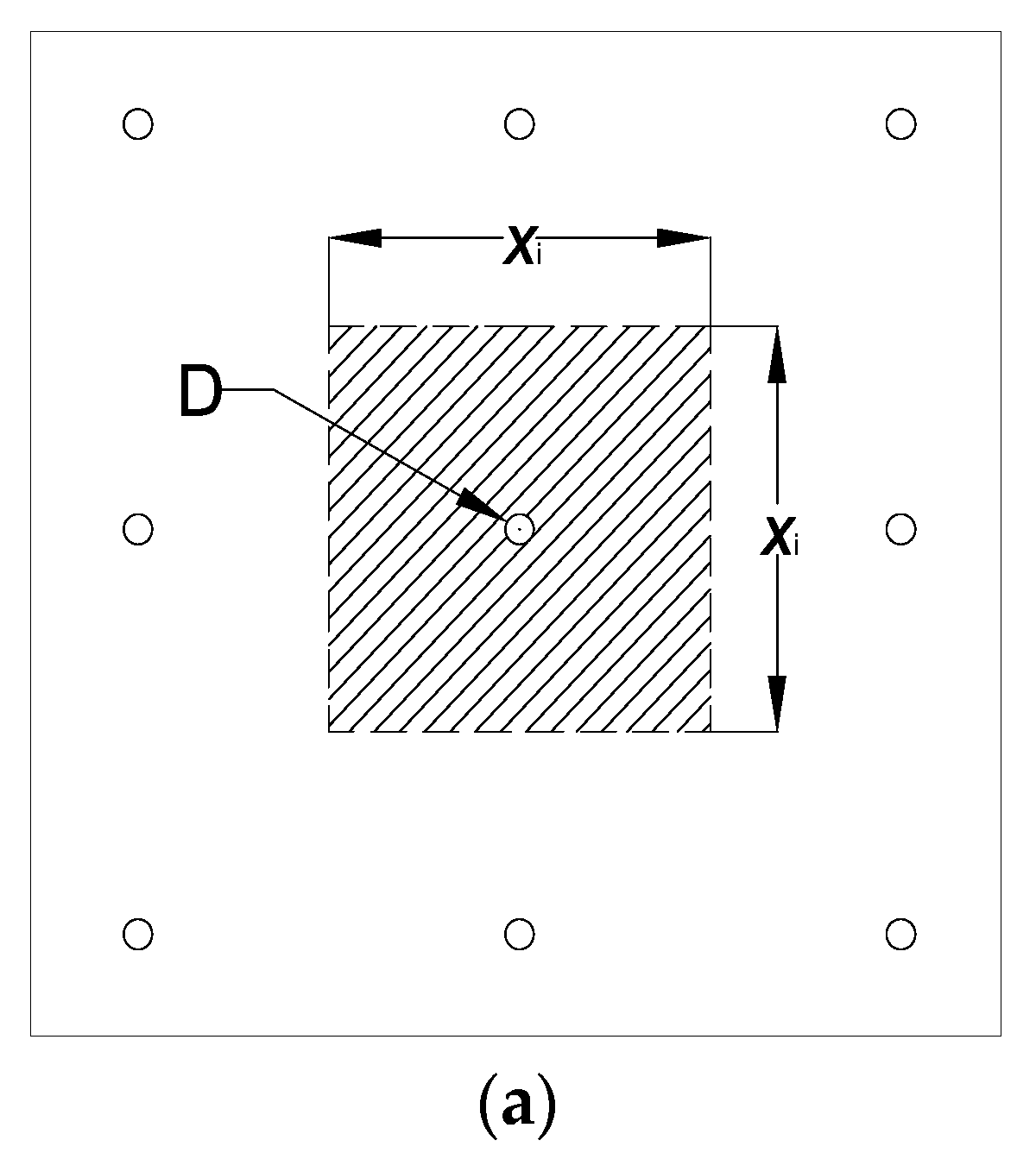
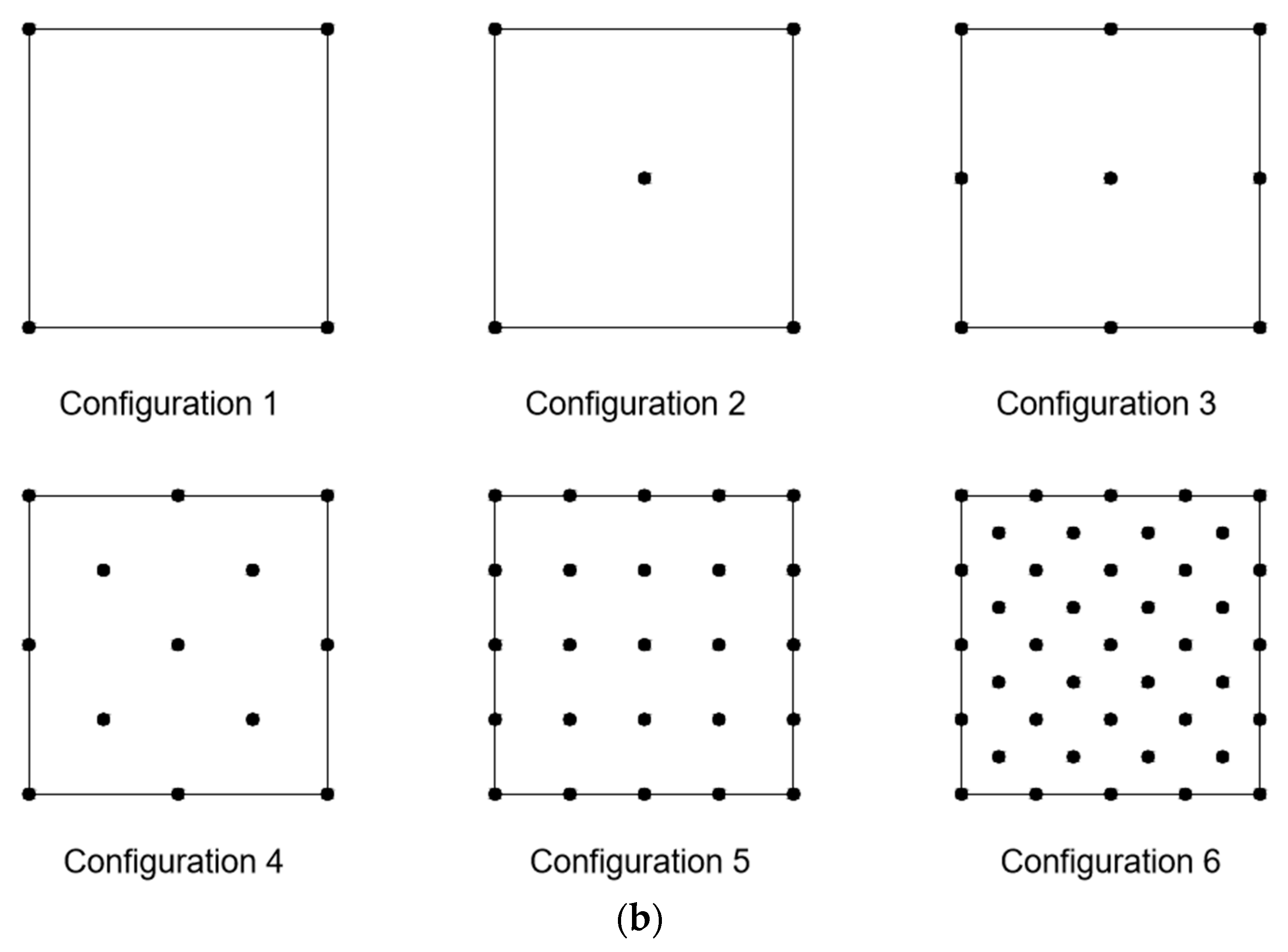
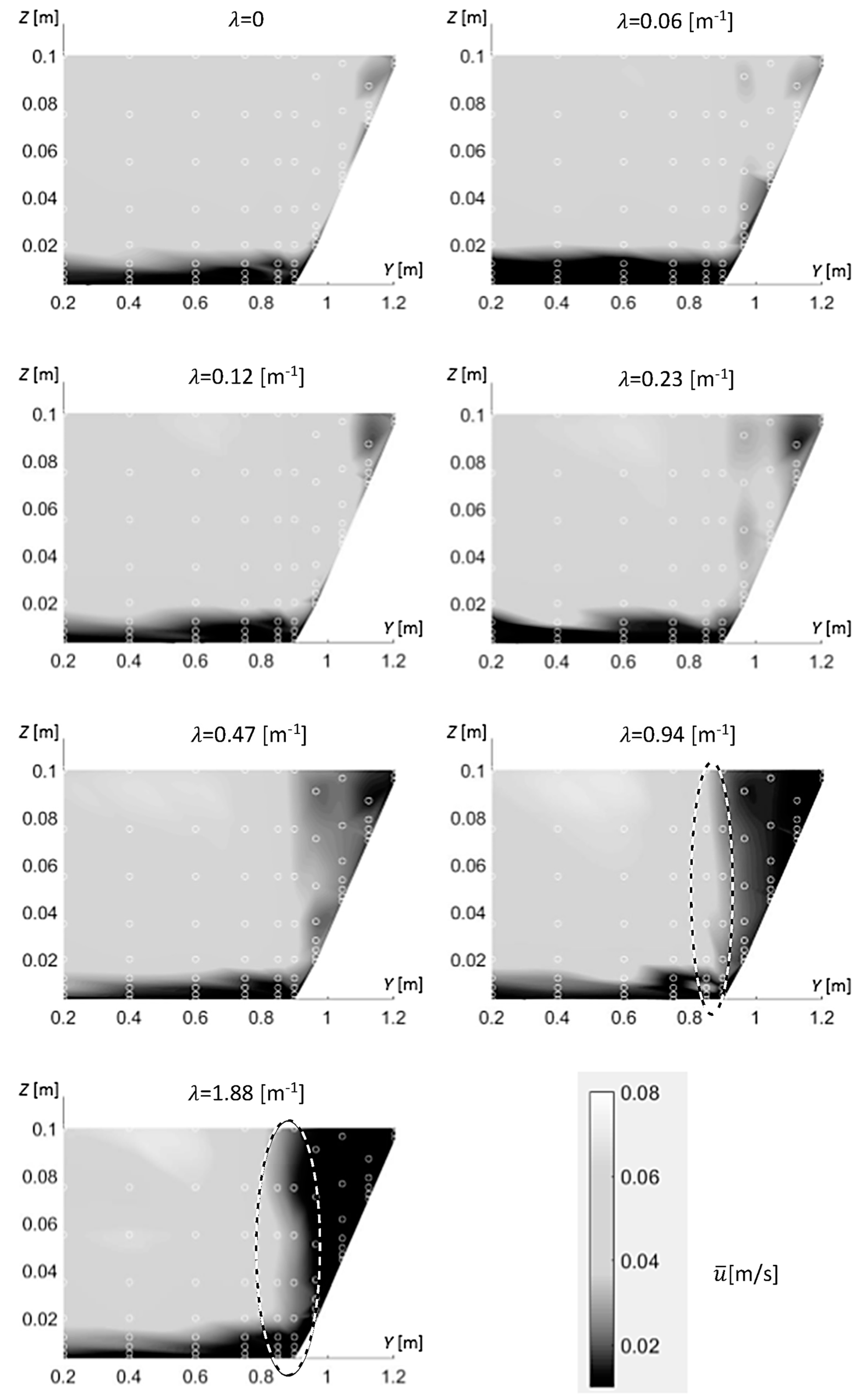
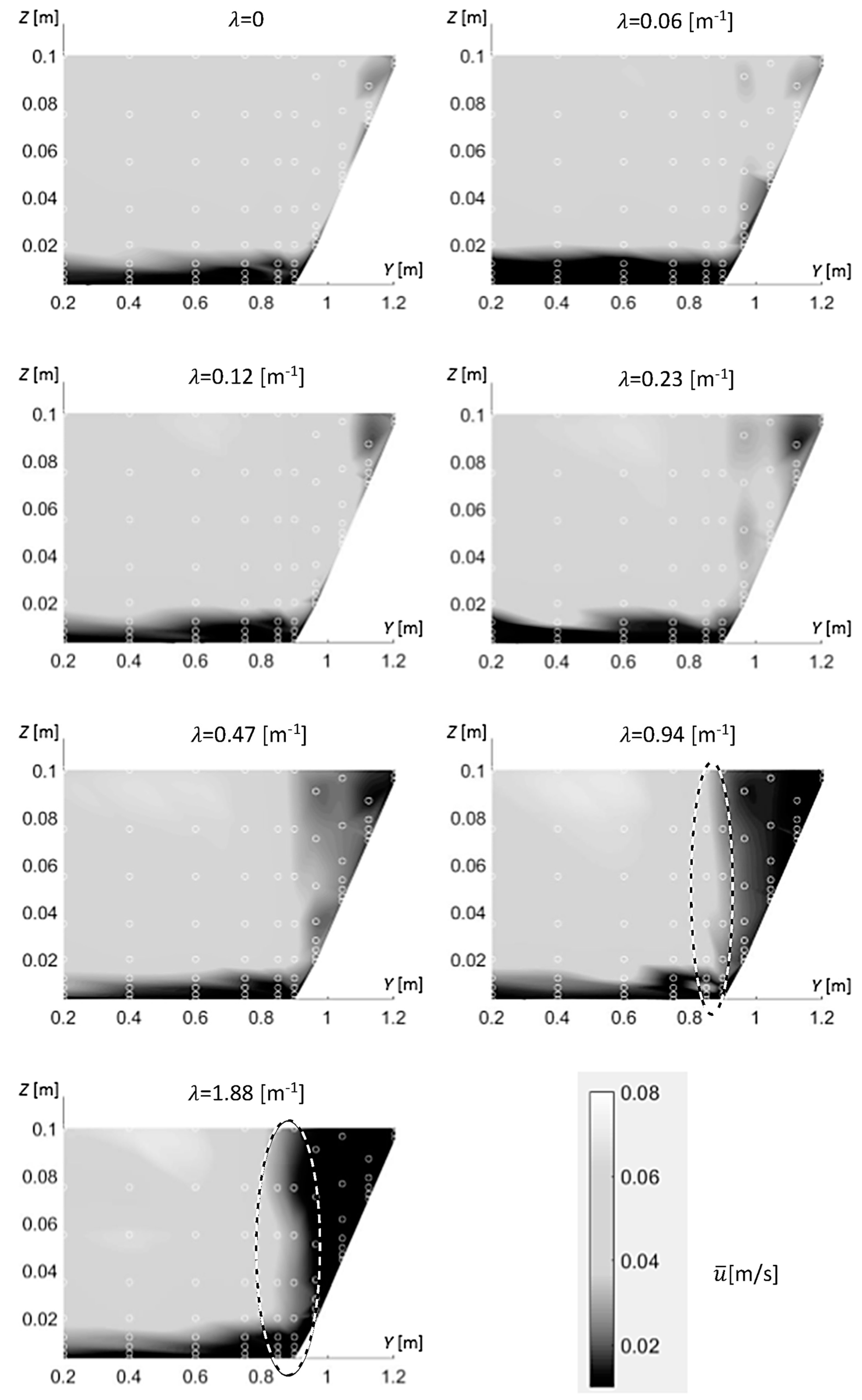

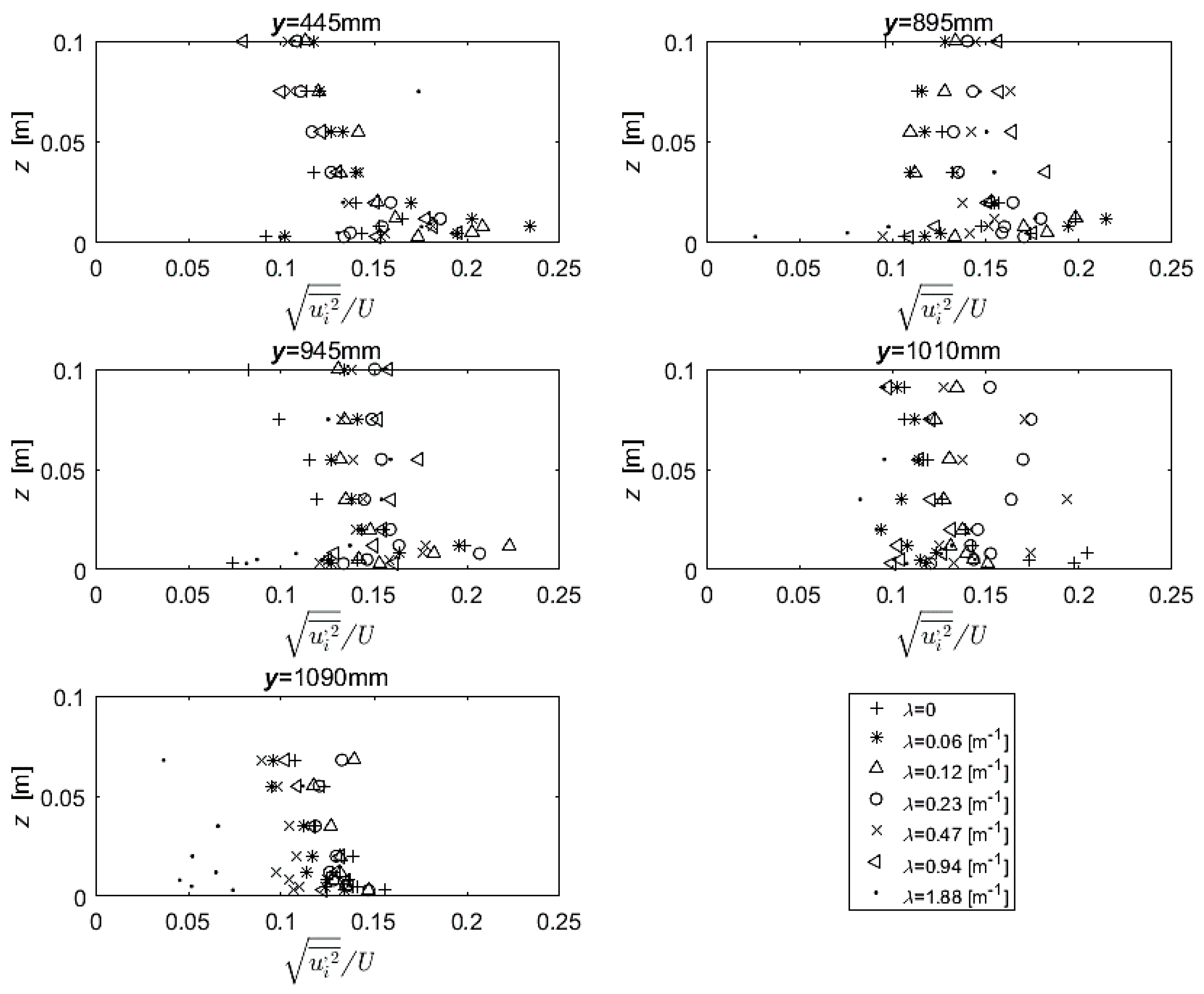

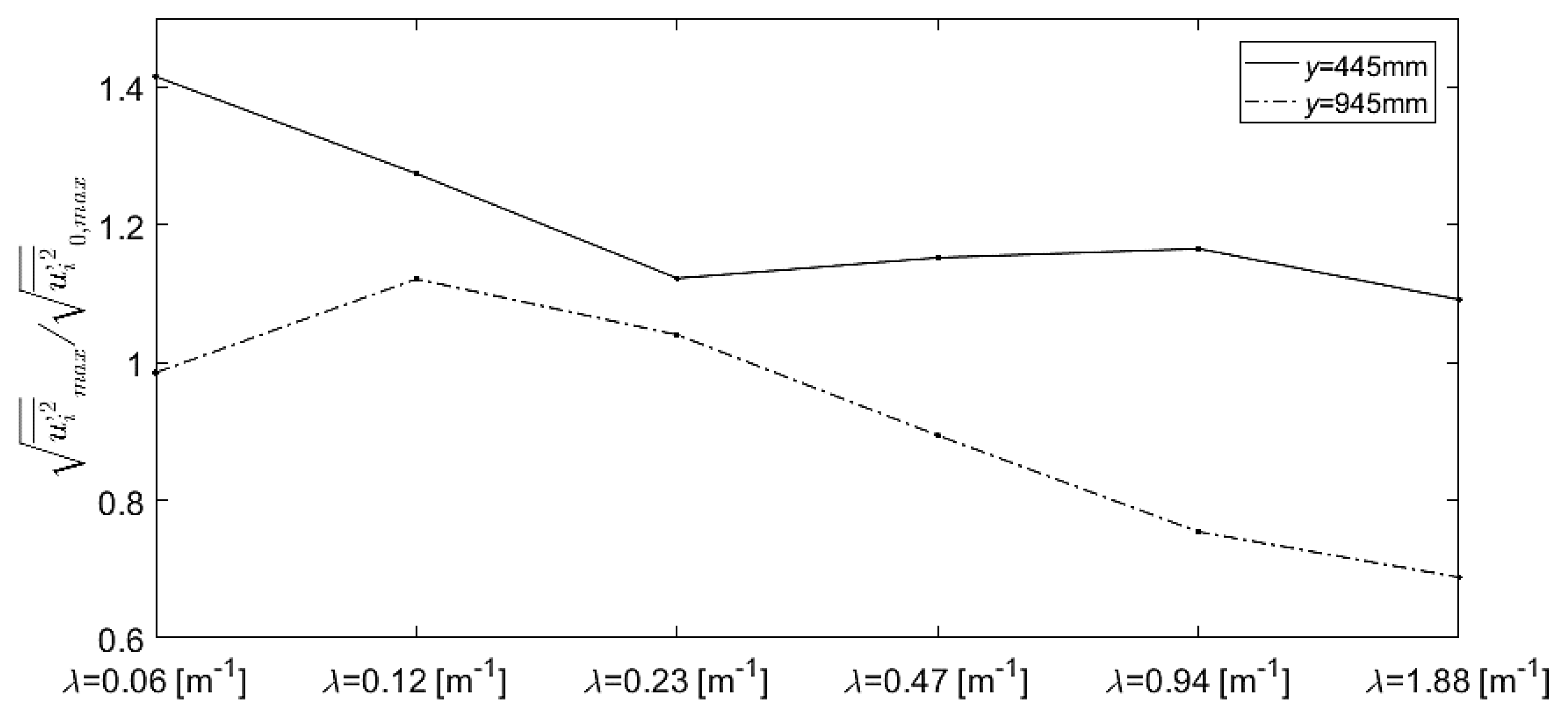
| Configuration (Density) | Rod Arrangement Type | [m] | [] | Number of Plants per m2 |
|---|---|---|---|---|
| 1 (low) | Linear | 0.320 | 0.586 | 10 |
| 2 (low) | Staggered | 0.226 | 1.172 | 20 |
| 3 (medium) | Linear | 0.160 | 2.344 | 39 |
| 4 (medium) | Staggered | 0.113 | 4.688 | 78 |
| 5 (high) | Linear | 0.080 | 9.375 | 156 |
| 6 (high) | Staggered | 0.057 | 18.75 | 308 |
| y [mm] | 245 | 445 | 645 | 795 | 895 | 945 | 1010 | 1090 | 1170 | 1250 |
| z [mm] | 100 | 100 | 100 | 100 | 100 | 100 | 91 | 68 | 41 | 21 |
| 75 | 75 | 75 | 75 | 75 | 75 | 75 | 55 | 35 | 16 | |
| 55 | 55 | 55 | 55 | 55 | 55 | 55 | 35 | 20 | 12 | |
| 35 | 35 | 35 | 35 | 35 | 35 | 35 | 20 | 12 | 8 | |
| 20 | 20 | 20 | 20 | 20 | 20 | 20 | 12 | 8 | 5 | |
| 12 | 12 | 12 | 12 | 12 | 12 | 12 | 8 | 5 | 3 | |
| 8 | 8 | 8 | 8 | 8 | 8 | 8 | 5 | 3 | * | |
| 5 | 5 | 5 | 5 | 5 | 5 | 5 | 3 | * | * | |
| 3 | 3 | 3 | 3 | 3 | 3 | 3 | * | * | * |
| λ [m−1] | 0 | 0.06 | 0.12 | 0.23 | 0.47 | 0.94 | 1.88 | |
|---|---|---|---|---|---|---|---|---|
| y = 445 mm | 0.16 | 0.23 | 0.21 | 0.18 | 0.18 | 0.19 | 0.18 | |
| Change compared to no vegetation | 0% | 42% | 27% | 12% | 15% | 17% | 9% | |
| y = 945 mm | 0.20 | 0.20 | 0.22 | 0.21 | 0.18 | 0.15 | 0.14 | |
| Change compared to no vegetation | 0% | −2% | 12% | 4% | −11% | −25% | −31% | |
© 2017 by the authors. Licensee MDPI, Basel, Switzerland. This article is an open access article distributed under the terms and conditions of the Creative Commons Attribution (CC BY) license (http://creativecommons.org/licenses/by/4.0/).
Share and Cite
Liu, D.; Valyrakis, M.; Williams, R. Flow Hydrodynamics across Open Channel Flows with Riparian Zones: Implications for Riverbank Stability. Water 2017, 9, 720. https://doi.org/10.3390/w9090720
Liu D, Valyrakis M, Williams R. Flow Hydrodynamics across Open Channel Flows with Riparian Zones: Implications for Riverbank Stability. Water. 2017; 9(9):720. https://doi.org/10.3390/w9090720
Chicago/Turabian StyleLiu, Da, Manousos Valyrakis, and Richard Williams. 2017. "Flow Hydrodynamics across Open Channel Flows with Riparian Zones: Implications for Riverbank Stability" Water 9, no. 9: 720. https://doi.org/10.3390/w9090720
APA StyleLiu, D., Valyrakis, M., & Williams, R. (2017). Flow Hydrodynamics across Open Channel Flows with Riparian Zones: Implications for Riverbank Stability. Water, 9(9), 720. https://doi.org/10.3390/w9090720




